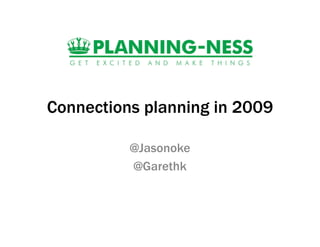
Connections Planningness
- 1. Connections planning in 2009 @Jasonoke @Garethk
- 2. Does anyone here have the job title “connections planner?” *we’re sorry in advance
- 3. Caveat – we don’t mean to paint everyone with the same brush. There is brilliant work done by connections planners out there. But as a total discipline, it’s in trouble.
- 6. The argument: Connections Planning hasn’t lived up to its promise.
- 7. Why Connections Planning is where it is: a brief history.
- 8. Once upon a time, some rich white guys decided to make money by spinning off media from creative agencies.
- 9. This separated the creation of ideas from the choosing of media ≠
- 10. The underlying assumption is that media is a container for holding messages – and turned media into a commodity to be bought primarily on price.
- 11. But at exactly the same time, the media landscape exploded.
- 12. And a new breed of ideas emerged, leveraging the particular strengths of different media.
- 13. Connections planning was an attempt to fix the mistake. +
- 14. It was the right idea. But we’ve mostly been using it the wrong way.
- 15. We use it to generate “stunts” for pitches and award shows.
- 16. We use it to turn everything into a medium.
- 17. We use it to find new places to interrupt people.
- 18. We create fake “movements” for things people don’t care about.
- 19. We create utility that isn’t useful to anyone.
- 20. Basically, we put more shit in more places.
- 21. And it’s not working.
- 22. The irony is connections planning doesn’t create very many connections.
- 23. Where did it all go wrong?
- 24. Connections planning was solving for the wrong problem.
- 25. It wasn’t trying to build greater value for brands or people. It was solving for agency problems. New revenue stream Sexy new business tool Award show friendly creative
- 26. It was dependent on the person who did it. We got connections planners, instead of connections planning. We don’t have a shared approach or way of working.
- 27. It’s like pornography: “I know it when I see it”
- 28. We applied the lens of advertising (interruptive, message-based) to new media. Instead we should apply the lens of new media (interactivity, iteration) to advertising.
- 29. The opportunity: Re-thinking the value of connections planning.
- 30. The opportunity: A new creative process, not an output.
- 31. A process of putting human connections at the heart of everything. Grounded in a deep understanding of what people are trying to do, what the brand is trying to do, and how people use media.
- 32. A journey, not a destination. Ideas as unfolding stories, a stream of iterations and interactions that invite people into the process.
- 33. Think of the flow of information over time. 365 day planning instead of 360 degree. Cultural latency is a strategic tool.
- 34. Think of the flow of information over geography. How do you create contextual value in each particular space?
- 35. Think of the flow of information over the depth of the story. How deep does the rabbit hole go?
- 36. Think of the flow of information over technology. How can each medium & technology be used to its full potential? The role of creative technologist is increasingly important.
- 37. weloveyouso.com
- 39. A plan for what happens after the connection. What will people do with it? How will they use it & share it? What might they remix? And what will that mean for the brand? How will we change because of our interaction with them?
- 40. Learn from other disciplines that create meaningful interactions. We need to absorb practices & approaches from design, information architecture, and user experience planning. Things like agility, rapid iteration, prototyping.
- 41. Connections Planning has more in common with Experience Planning than media planning. We are all experience designers, whether we think of ourselves that way or not.
- 42. Focus on maximizing value for all. Create thick value, with interactions that are rewarding for everyone – media provider, participant, brand.
- 43. It isn’t just about digital. It’s about planning for interaction.
- 44. Television
- 45. Solve real problems. At the end of the day, our job is straightforward: What’s the business problem? What audience can best solve that problem? What response do they need to have? What experience could generate that response?
- 46. And the solution could live anywhere.
- 47. Embrace the one-off. Do we worry too much about campaigns? Sometimes, affecting one thing well is powerful. Commitment, not campaigning It gives you a chance to learn: a one-off is just something you haven’t figured out how to dimensionalize yet.
- 48. We all have the same job: making better ideas. Whatever the job function, everyone’s job is additive to a shared goal. You’re not responsible for the brief or the channel plan but for the idea. That requires a fluid iterative interchange of strategic, media, and creative thinking.
- 49. The $64,000 question: Is connections planning a separate discipline? Are we niche-ing ourselves into irrelevance with splintered sub-disciplines? Should these just be core planning skills?
- 50. Topics for discussion: 1) Is connections planning a separate discipline? Or a core planning skill? 2) What skills/methods do we need to absorb from other disciplines? 3) What could the new ‘idea’ team look like? 4) What’s holding us back from evolving?
